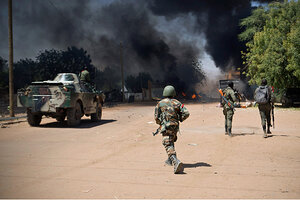Al Qaeda growing, but less focused on US, study finds
The number of Al Qaeda affiliates has expanded, as have their geographic scope, but the terror network has become more diffuse and decentralized, the RAND study found.

Malian soldiers, working with French forces, battling radical Islamic rebels in Gao, Mali, Feb. 21. Al Qaeda not only remains a threat to the United States, but its capabilities and scope are expanding, a new analysis from a respected think tank has concluded.
AP/File
Washington
Al Qaeda not only remains a threat to the United States, but its capabilities and scope are expanding, a new analysis from a respected think tank has concluded.
“There has been a net expansion in the number and geographic scope of Al Qaeda affiliates and allies over the past decade, indicating that Al Qaeda and its brand are far from defeated,” argues Seth Jones, an analyst at the RAND Corporation and the study’s author.
Why, after a decade of wars – the longest in America’s history – is the terrorist organization that the US military set out to defeat still active and growing? And does it really have an impact on the everyday safety of most Americans?
There are a few reasons for the growth of the terrorist group, Mr. Jones argues. “One is the Arab uprisings, which have weakened regimes across North Africa and the Middle East, creating an opportunity for Al Qaeda affiliates and allies to secure a foothold.”
This expansion – coupled with the weakness of central Al Qaeda in Pakistan – “has created a more diffuse and decentralized movement,” Jones added in little-noted testimony last week before the House Foreign Affairs Committee on the topic of “Re-examining the Al Qaeda Threat to the United States.”
As a result, most of Al Qaeda’s local affiliates “largely run their operations autonomously, though they still communicate with core leadership in Pakistan and may seek strategic advice.”
The good news is that within this disparate movement, most Al Qaeda affiliates and allies are not actively plotting attacks against the US homeland, according to the RAND analysis.
“Contrary to some arguments, most Al Qaeda leaders are not interested in establishing a global caliphate and do not seek to overthrow regimes in much of the world,” Jones writes.
Instead, they tend to have rather more parochial goals. “They want to establish Islamic emirates in specific countries or regions, though they may be agnostic about a broader violent jihad.”
The goal for Al Qaeda in the Islamic Maghreb, for example, is to overthrow regimes in North Africa, particularly Algeria, and replace them with an Islamic government, Jones notes.
In many cases, “France, rather than the United States, is the most significant foreign enemy.”
Captured Al Qaeda documents show that both Osama bin Laden and the current Al Qaeda leader, Ayman al-Zawahiri, primarily emphasized guerrilla campaigns to overthrow “apostate” governments in the Middle East.
Indeed, approximately 98 percent of Al Qaeda attacks between 1998 and 2011 “were part of an insurgency where operatives tried to overthrow a local government or secede from it – and were not in the West.”
That said, Al Qaeda affiliates do pose some threat to US citizens overseas. The RAND analysis notes that Al Qaeda in the Islamic Maghreb and its allies were involved in the 2012 attack that killed US Ambassador Christopher Stevens in Benghazi, Libya, for example.
There also have been a growing contingent of foreign fighters – perhaps several thousand, according to Jones, who has served as an adviser to the Pentagon – traveling to Syria to fight. Many of these volunteers are coming from Europe.
This is a problem because “volunteering for war is the principal stepping stone for individual involvement in more extreme forms of militancy,” Jones argues. “When Muslims in the West radicalize, they usually do not plot attacks in their home country right away, but travel to a war zone first.”
So what should US officials do about these expanding networks?
“In areas where Al Qaeda does not pose a significant threat to the homeland, the US government should support local countries and allies as they take the lead – much like the United States did in supporting France’s counterterrorism efforts in Mali in 2013,” notes the RAND analysis.
When they do pose a direct threat, the key is “implementing a light footprint strategy that focuses on covert intelligence, law enforcement, and Special Operations Forces to conduct precision targeting of Al Qaeda and its financial logistical support networks,” Jones says.
“In Afghanistan, for example, “the United States should withdraw most conventional forces, relying primarily on clandestine operatives as it has done in Colombia, the Philippines, and other counterinsurgencies.”
That’s because most of the terrorists involved in serious homeland plots after Sept. 11 – from Jose Padilla’s plot to blow up apartment buildings in the US to Najibullah Zazi and Faisal Shahzad’s plots to conduct terrorist attacks in New York City – “were motivated by large US conventional military deployments overseas.”
The US should also engage more robustly in psychological warfare, according to the report. Unlike the role of the US Information Agency, which was disbanded in 1999, there is no government department responsible for taking the lead role in countering Al Qaeda ideology.
“The CIA is involved in some clandestine activity, but most senior officials do not view undermining Al Qaeda ideology as its core mission,” Jones says. “Ultimately it is the president and the national security staff’s responsibility to appoint a lead agency and hold it responsible.”
The bottom line is that US policymakers, the analysis ominously concludes, “should view the Al Qaeda threat as a decades-long struggle like the Cold War.”

